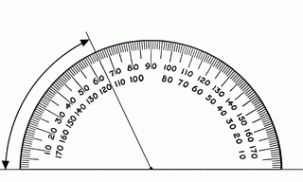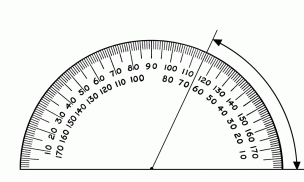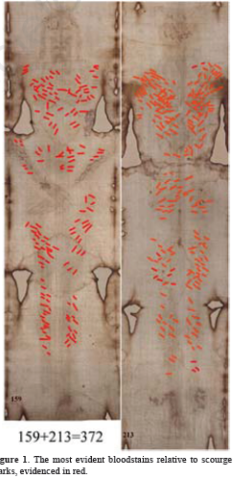The Shroud of Turin has the markings of being a burial cloth of Jesus. It is kept at the Vatican in Rome. It has been scientifically tested and the results are listed below. (Sorry for the length of this page but felt it was extremely important.)
A man did an autopsy on the image of the Shroud and came up with a report that is unforgettable. New testing on the Shroud reveals the date of 33 AD + or -250 yrs.
Information about the victim and position of the body:
- Between the ages of 30-45
- Adult Male
- About 175 lbs
- Height 71 inches or about 5ft 11in
- Long hair with a small braid in the back. Short beard with a fork in the middle.
- The left foot is on top of the right foot with left knee flexion maintained by rigor mortis.
- The body has marks of two coins on the eyes.
- The chest is expanded in an upward inhalation position.
- The body is nude.
- The victim would have been upright with arms over his head at the time of the whipping.
- The body was in a crucifixion-type posture at the time of death.
- Arms are crossed over lower abdomen. The arms would have been in a 65 degree position, on the cross, for the blood to fall the direction it did. See below.


The wounds He suffered:
- SCALP: There are about 30 puncture wounds all over the scalp. One blood stain is in the shape of the number 3.
- FACE: The person has a swollen left cheek and nose cartilage is shifted to the right side with an abrasion. Probably from direct blows.
- SHOULDER: There are abrasion marks on his shoulder and shoulder blade from carrying a heavy cross or beam. Possible shoulder dislocation with right shoulder lower than the left.
- SIDE/RIBS: Puncture wound between his right 5th and 6th ribs about the size of a spear head. This shows two types of fluid, blood and “water” from the wound. The blood most likely came from the heart sac being pierced. The serum most likely came from the heart sac due to a ruptured heart from a stress induced heart attack.
- ABDOMEN: The abdomen is distended
- WRISTS/ARMS: There are wounds in the wrists where the median nerve is located. The body weight during crucifixion causes the nail to damage the median nerve and the thumb to flex inward to the palm. Blood flows wiggle along the arm in response to the the person lifting up and down to breathe.
- SCOURGE MARKS: There are scourging wounds from the shoulders to the calves from a whip with two hard dumbbell-shaped pieces tied to the tails. A typical Roman flagrum whip. Lots of marks seen on buttocks, thighs and shins. Typical injury is severe bruising, lung injury, broken ribs, connective and muscle tissue damage. Broken ribs can cause damage to rib veins and arteries during breathing and bleeding into the lung sac. There are maps online of the scourge marks counting 159 on the front, 213 on the back and 372 total! If the whip had 3 tails that would be 124 times of being whipped. Some marks are in groups of three below.

- LEG/ANKLE: The left ankle looks dislocated. No broken legs.
- KNEECAP: The left knee and kneecap are swollen and looks possibly fractured. Probably from falling with a heavy cross.
- FEET: There is a puncture wound in the right foot. The same object penetrated both feet with the left being over the right. This can cause considerable blood loss.
Blood:
- Human Blood type AB, 3% of population, 1 in 7 billion and is the “universal recipient” for blood donation. The blood is very red possibly from UV irradiation. Blood turns red in UV irradiation but turns brown without.
- Whole blood and serum found. Proteins, albumin, and bilirubin found in the serum. High amounts of bilirubin found from scourging.
- Potassium and iron found.
- Sodium and Chloride found suggesting sweat.
- Human globulins (part of the immune system) found.
Cause of death:
- asphyxia by the position of his body during the crucifixion and exhaustion
- severe blood loss from flesh wounds causing shock, dehydration and difficulty with blood clotting
- accumulation of fluid in the chest cavity due to cardio-respiratory failure
- compromised circulation due to intense pain
- too much pressure in the chest
The persons who did the autopsy said that they felt that the injuries shown on the cloth coincided with the Gospel and the death and crucifixion of Jesus.
I hope you stop and think about what He went through for the forgiveness of your sins. Picture it in your mind, you standing there watching his agony. I want to cry each time I think about it. When you look at the injuries above that He suffered for us, it becomes more than what you see in pictures or on a crucifix. He suffered excruciating pain in every part of his body for hours before he died. He was betrayed, mocked, spit on, hit, scourged, punctured with the crown of thorns, had to carry the heavy cross, nailed to the cross, hung on the cross for three agonizing hours, had to lift his body to breathe even though he had horrible pain in his wrists and feet, had a broken kneecap and possibly a broken nose and dislocated shoulder and ankle, and he, an innocent man, died for us. He loved us that much that he would gladly suffer all of that pain for the forgiveness of our sins. We don’t deserve his love but he gives it to us freely. He suffered and died for us, what are we doing for Him? Not enough, I’m sure. Yes, he has risen but do you realize that each time we sin or blaspheme, it hurts him the same as if we were standing there whipping him ourselves? He’s not up in heaven all smiles, he’s in agony yet because we are hurting him with our sins. Many people say “OMG” but that’s a blasphemy against God. Something that simple can cause that agony for Jesus. We have no true sense of the pain He went through but we should try very hard not to cause Him anymore pain by sinning.
http://www.theholyshroud.net/Body.htm
